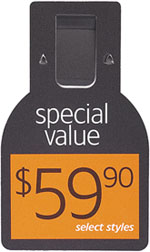Sorry, Charlie. Price promotions may not be the best way to increase sales of canned tuna — or any other frequently purchased consumer good.
The iconic cartoon mascot never got the message: “StarKist doesn’t want tuna with good taste; it wants tuna that tastes good.” Some companies may not be getting the message that “if value is driven only by price, price becomes the only value proposition you have,” said Chakravarthi Narasimhan.

According to Narasimhan, a marketing professor at the Olin Business School at Washington University in St. Louis, “managers can be overly focused on losing market share and get caught up in a mindless cycle of discounting – without regard to the long-term implications of their actions.”
Take automobile manufacturers, for example.
Dealers want to move more vehicles. In response, manufacturers initiate price promotions, offer rebates and lower buyers’ financing costs. “The additional volume that comes from these promotions will slowly fall,” Narasimhan said. “Why? In the mind of the consumer, there’s always another promotion and no real pressure to buy at a particular time. This dynamic, in turn, leads companies to continue price promotions.
“Strategic consumers are those who form expectations about future prices,” he explained. In other words, they anticipate that certain products fluctuate in price and react in one of several ways.
Narasimhan and fellow researchers Tat Chan, associate professor of marketing, and Qin Zhang, assistant professor of marketing at the University of Texas at Dallas, examined A.C. Nielsen scanner panel data to compute the canned tuna purchases of 1,000 randomly selected households in Sioux Falls, S.D., during a 123-week period. Their study focused on 6.5-ounce cans and included StarKist, Chicken of the Sea, 3 Diamonds, private-label and other brands.
They proposed “a dynamic structural model to understand the impact of temporary price promotions on households’ behavior and determine the amount of consumption increase, brand switching and stockpiling.”
Although some consumers switched brands to take advantage of any sale, loyal customers stocked up on their preferred brand when its price was reduced. A price cut caused light users to increase their consumption of canned tuna, but heavy users stored cans. Narasimhan, Chan and Zhang found price promotions could hurt large-share brand profits in the long run. An increase in sales at a lower price frequently came at the expense of future sales at the full price. Similar conclusions were drawn when the researchers looked at data from the paper towels category.
Managers can use these findings to develop more effective pricing and promotion strategies. They must keep in mind customers vary in their needs, preferences and ability (or willingness) to pay a certain price for a product or service. Understanding this kind of consumer behavior is critical.
Narasimhan said companies can drive value in ways other than price. For instance, a business could improve customer service, initiate a customer loyalty program or enhance the emotional appeal and image of a particular brand.
Find creative opportunities to benefit from the entire marketing mix, he advised. “Retain loyal customers through nonprice, value-added components, and limit discounts to entice new buyers or brand switchers.”
Narasimhan, Chan and Zhang’s paper, “Decomposing Promotional Effects With a Dynamic Structural Model of Flexible Consumption,” will be published in the Journal of Marketing Research.
Editor’s note: Professors Narasimhan and Chan are available for live or taped broadcast-quality interviews using Washington University’s free VYVX or ISDN lines. Please contact Shula Neuman at (314) 935-5202 for assistance.